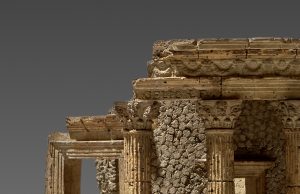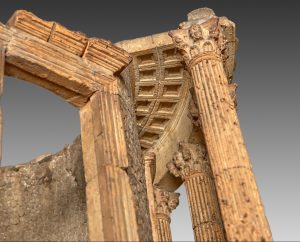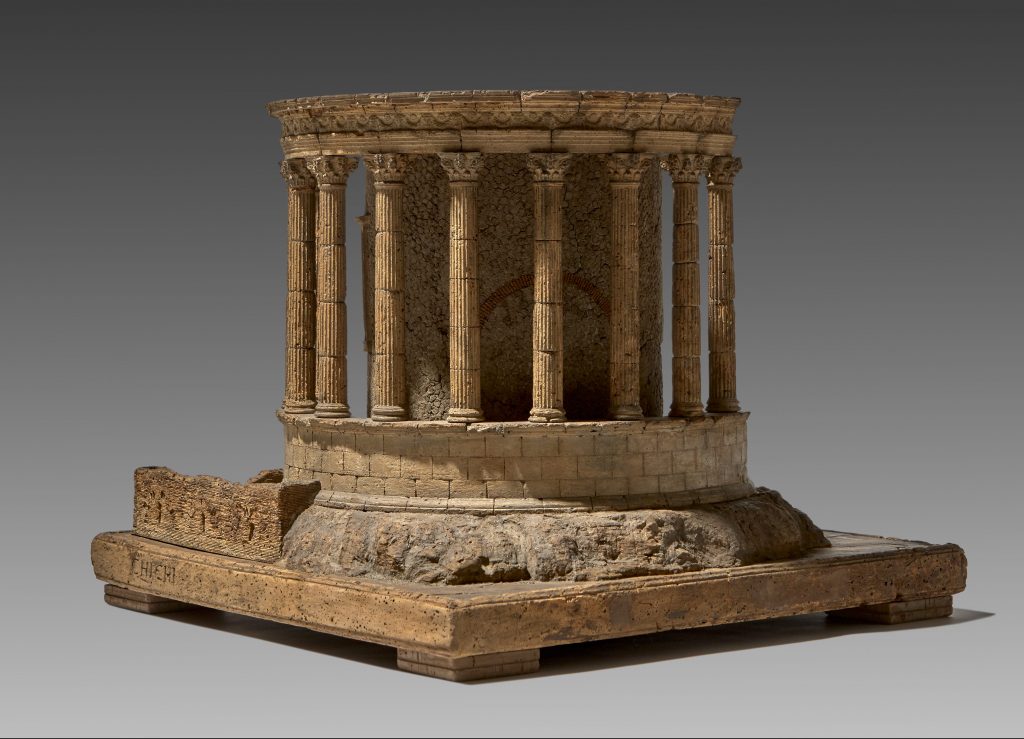Antonio Chichi
(1743 - Rome - 1816)
A Cork Model of the Temple of the Sibyl at Tivoli, Rome c.1790
Cork, wood, pigmented gilder’s composition, French chalk ground, mineral pigments, dried moss, 46 x 46 x 38 cm
Bearing a label on the underside (possibly an inventory label) inscribed F P. V. 43
Provenance:
Eila Grahame (1930-2009), London
Comparative Literature:
Peter Gercke, Antike Bauten: Korkmodelle von Antonio Chichi 1777-1782, Kassel 2001
Martin Eberle, Monumente der Sehnsucht: die Sammlung Korkmodelle auf Schloss Friedenstein Gotha, Heidelberg 2017
This cork model was executed on a scale of 1:40 and is a very precise depiction of the Temple of the Sibyl – also known as the Temple of Vesta – at Tivoli. The Temple was erected around 100 BC on the site of the ancient acropolis of Tibur (now Tivoli). The Temple’s elegant design and its spectacular setting high above the Aniene waterfalls earned it a reputation as the embodiment of the ‘pittoresque and sublime’. It became a highlight for every Grand Tour Traveler. A landmark destination for visitors to Rome, it was one of the most frequently depicted sites. It inspired a large number of versions designed as landscape features. These constructions are still to be seen in many of Europe’s great parks and landscape gardens. It is therefore no surprise that cork models of this particular motif proliferated, but very few have actually survived. Most of the models by Chichi that are preserved have a princely provenance and are on public display in museums. Examples are held in St. Petersburg, Gotha, Kassel and Darmstadt.
Although the Temple’s spectacular position overlooking the waterfalls contributes to its mystique, the setting is omitted in the surviving models. In the present model the only indication of a substructure – still recognizable in situ – is a brick wall placed across one corner. The fact that the structure has been isolated from its topographical context reflects architectural conventions of the period. This is a mark of a ‘serious’ reproduction designed to achieve maximum accuracy in terms of proportion.
The model is mounted on a stable, rectangular wooden structure with four small square feet made of cork. The structure is framed with a band or border of cork that has been partially made up. At the front, the cork border bears the incised inscription TEMPIO DELLA SIBILLA IN TIVOLI. The maker’s name – CHICHI – is incised into the right border. It is likely that, for reference purposes, a small strip of paper with a scale bar in Roman piedi and Roman palmi was at one time attached to this border – a mark of Chichi’s focus on archaeological precision. The podium and columns of the temple are fashioned in cork and reproduce the cut of the ancient stone. The capitals and the frieze are intricately worked in pigmented gilder’s composition.
 An inscription on the architrave of Chichi’s model reads L.GELIO L.F. and is particularly surprising in that Chichi’s transcription is orthographically incorrect. The inscription on the architrave of the original building reads L.GELLIO L.F., almost certainly referring to the Roman architect Lucius Gellius[1] who as Curator of Public Buildings in the ancient town of Tibur was responsible for the construction of the Temple. Chichi’s error may, however, help to establish a more exact dating of the present model. There is no inscription on his models of the Temple of Vesta preserved in Gotha (executed 1777-78) and Kassel (1777-82). On the somewhat later Darmstadt model (1790-91) the inscription also reads L.GELIO instead of L.GELLIO. It therefore seems likely that the present model and the Darmstadt model were executed at around the same time, namely circa 1790.
An inscription on the architrave of Chichi’s model reads L.GELIO L.F. and is particularly surprising in that Chichi’s transcription is orthographically incorrect. The inscription on the architrave of the original building reads L.GELLIO L.F., almost certainly referring to the Roman architect Lucius Gellius[1] who as Curator of Public Buildings in the ancient town of Tibur was responsible for the construction of the Temple. Chichi’s error may, however, help to establish a more exact dating of the present model. There is no inscription on his models of the Temple of Vesta preserved in Gotha (executed 1777-78) and Kassel (1777-82). On the somewhat later Darmstadt model (1790-91) the inscription also reads L.GELIO instead of L.GELLIO. It therefore seems likely that the present model and the Darmstadt model were executed at around the same time, namely circa 1790.
Chichi’s skill in modelling cork surf aces to create an optical portrayal of the stonework of ancient buildings is particularly evident in his handling of the wall of the circular cella or main body of the Temple. The original wall is an example of a Roman construction technique known as opus incertum where stones or blocks are inserted into a core of concrete, with an outer surface made up of small, irregular pebbles and rock fragments. Chichi’s imitation of the technique displays an astonishing mastery, particularly in the upper part of the wall where he applied pebbles formed of gilder’s composition to reproduce the uneven surface. In the lower part of the wall he simulated a dark patch of repair work using coarsely ground basalt. The repairs are visible on the original wall and were very likely carried out in the Middle Ages. His depiction of the Corinthian capitals is remarkably precise and carefully imitates the architectural style current at the beginning of the first century BC, even though it was not consonant with the classicist aesthetic of the eighteenth century.
aces to create an optical portrayal of the stonework of ancient buildings is particularly evident in his handling of the wall of the circular cella or main body of the Temple. The original wall is an example of a Roman construction technique known as opus incertum where stones or blocks are inserted into a core of concrete, with an outer surface made up of small, irregular pebbles and rock fragments. Chichi’s imitation of the technique displays an astonishing mastery, particularly in the upper part of the wall where he applied pebbles formed of gilder’s composition to reproduce the uneven surface. In the lower part of the wall he simulated a dark patch of repair work using coarsely ground basalt. The repairs are visible on the original wall and were very likely carried out in the Middle Ages. His depiction of the Corinthian capitals is remarkably precise and carefully imitates the architectural style current at the beginning of the first century BC, even though it was not consonant with the classicist aesthetic of the eighteenth century.
Vestiges of extraordinarily well-preserved polychrome paint show how skillfully the opaque, mineral character of the stone has been imitated. To achieve this effect, mineral pigments were used with a minimum of binding agent, making the paint extremely sensitive to abrasion. This almost certainly points to the reason why the coloring on most of Chichi’s other models is in somewhat poor condition.
Eighteenth-Century Cork Models of Ancient Ruins
Valentin Kockel, Professor Emeritus, Augsburg University
On 12 November 1767 an entirely novel object was presented at the Society of Antiquaries of London, the historic British Society dedicated to ‘the encouragement, advancement and furtherance of the study and knowledge of the antiquities and history of this and other countries’. The object was a large model depicting the ruins of the circular Roman temple at Tivoli and made for the most part out of cork and wood. The model had been sent to the Society as a gift from Thomas Jenkins, an English painter, connoisseur and art dealer living in Rome. He had joined the Society of Antiquaries in 1757. In an accompanying letter Jenkins detailed what he considered to be the important elements that contributed to the exceptional quality of the model – it had been built by ‘a man of very singular talents whose merit consists in making Models of the Antiquities’, and one who had selected as his subject the circular temple at Tivoli as being ‘one of the most elegant & pittoresque Objects in the Country’; it was based on a new plan drawn up by an architect specially for the model maker; and finally, coloring had been added by a landscape painter ‘to complete the imitation’ – to the delight of all those who had seen the piece.
The model presented to the Society is the oldest recorded cork model of an ancient ruin. The genuine – or alleged – qualities described by Jenkins were responsible for the extraordinary success of cork models with collectors and architects in the following hundred years.
Old Master paintings, landscapes and city views, together with original antiquities – particularly sculptures – had figured on the purchasing lists of Grand Tourists since the mid-eighteenth century. Extremely large sums of money regularly changed hands and the objects were in addition subject to customs duties. There was also a lively trade – albeit in a lower price range – in volumes of prints, for example bound collections of etchings by Piranesi and his family, and engravings after famous masterpieces and works of art considered to be representative. Nowadays, these are readily described as ‘souvenirs’, but their original purpose was to provide much more than a banal travel memento. They were chosen to introduce a tangible sense of the Grand Tour, its aesthetic context and the artworks seen on the Tour into the ambience of the Tourist’s own residence, not least to attune works from his existing collection to the canonical works representative of the classicist perception of art to be exhibited alongside them. Traditional methods of reproduction set out to achieve maximum precision in the representation of three-dimensional objects, though to contemporary eyes no drawn or printed image could achieve such a high level of authenticity. Antique engraved gemstones (or intaglios) were popular collector’s items. In addition, as a substitute for these, a taste developed for collections of casts or impressions of intaglios made from plaster or a composition of sulphur and wax – so-called dactyliothecae. These featured a systematically assembled iconography of ancient myths and heroic legends. Coins and casts of coins provided a visual representation of the powerful rulers of antiquity. Instead of the Medici Venus – unattainable even for the richest of English connoisseurs – a collector could relive his enjoyment of the sculpture’s aesthetics by acquiring a studio-fresh plaster cast or a smaller-format bronze copy of it. Collectors were thus able to surround themselves with something of a museum in miniature bringing together representations of many of Italy’s famous and far-strewn masterpieces. Technical problems arose, however, in the case of architectural structures. The dimensions of single architectural components such as capitals were hard to handle because of their monumentality. And this applied even more strongly to entire buildings where an integral part of their effect derived from their sheer size, towering over and dwarfing human beings. Although there were isolated cases of architects owning casts of ornamentation and decorative detail, the creation of easily transportable replicas viewable from all sides did not become possible until the ‘invention’ of cork models, which reproduced scale replicas of ancient, mostly-ruined buildings.
Jenkins, like a number of others, recognized that cork, with its porous consistency, was the ideal material for imitating the porous limestone of Paestum, and equally ideal for depicting the natural travertine found in Rome, despite its greater density. He saw that special skills were fundamental to the creation of high quality architectural models and his plan to exploit this by engaging a variety of specialists and making them responsible for different stages of the work was hugely successful. English connoisseurs like Charles Townley and antiquity enthusiasts like Catherine the Great commissioned entire series of models. These commissions saw the emergence of three important makers of cork models in Rome in the late 1760s. One was the ‘man of very singular talents’ mentioned above and identifiable as Giovanni Altieri of Naples (documented circa 1767-97). The other two were Augusto (Agostino) Rosa (1738-84) and his contemporary Antonio Chichi (1743-1816). All three made models of the same antique ruins in Rome and its surroundings and also produced models of the Doric temples in Paestum. They were each directly dependent on relations with art dealers, whose clients were chiefly to be found among members of the nobility. Altieri worked for English and French collectors through the intermediary of Jenkins and Jenkins’s rival, the Scotsman James Byres. Rosa also had dealings with English and French collectors through Piranesi. Chichi’s models were sold by the Baltic Hofrat Friedrich Johann Reiffenstein to buyers in Russia and Germany. Here, extensive collections were formed and the models provided important training opportunities for emerging painters and architects. Most of the English collections were of modest size, with the exception of the collection of Sir John Soane – himself an architect – which was formed later and is still extant. Another exception was Richard Dubourg’s collection which he set up as a show running in London for several decades – an entrance fee was charged to see sites on the Grand Tour.
 Enthusiasm for the visual appeal of the models was widespread. In 1770 a collector, on seeing a model of a Tivoli temple, commented: ‘At the sight of the model it is as if one would espy the original […].’ In Gotha a little later, another viewer seeing one of the first models to be presented in Germany noted: ‘One believes oneself to be standing before it.’ Experienced travelers to Italy claimed that they recognized the very stone they had stumbled over in the Colosseum. Cork quickly grew to be synonymous with the depiction of the age and ruined state of antique buildings. Skills were such that it mattered little whether the original structures were made of marble or brick.
Enthusiasm for the visual appeal of the models was widespread. In 1770 a collector, on seeing a model of a Tivoli temple, commented: ‘At the sight of the model it is as if one would espy the original […].’ In Gotha a little later, another viewer seeing one of the first models to be presented in Germany noted: ‘One believes oneself to be standing before it.’ Experienced travelers to Italy claimed that they recognized the very stone they had stumbled over in the Colosseum. Cork quickly grew to be synonymous with the depiction of the age and ruined state of antique buildings. Skills were such that it mattered little whether the original structures were made of marble or brick.
The most successful of the three ‘inventors’ of phelloplastic – a depiction that has been modelled in cork – was Antonio Chichi. This was due to the exceptional quality of his work. On Rosa’s death in 1784 and after Altieri’s return to Naples in 1785, Chichi remained the last important model maker working in Rome. He was the only one of the three to describe himself as an architetto – an indication of his aspiration to a professional rank superior to that of an ordinary craftsman. His repertoire of subjects by this time extended to thirty-six ancient buildings in Rome and the surrounding area. He successfully sold complete series of models to buyers in St. Petersburg, Darmstadt and Kassel. He sent out offers of work to potential buyers in Gotha, Berlin and other cities. His range of subjects spanned the entire spectrum of ancient Roman architecture – rather like a three-dimensional handbook of the city – from temples of different architectural orders and differing ground plans to domed structures and triumphal arches; buildings for leisure activities like amphitheaters and thermal baths; monumental tombs and even a whole series of well-engineered structures such as bridges and aqueducts. Chichi’s models won him the recognition of his contemporaries. This is partly attributable to his approach to his work, which was more pragmatic than that of his rivals, and partly to his meticulously precise handling of architectural detail. He created capitals, friezes and reliefs by pressing gilder’s composition into reverse-cut matrices and then incorporated these architectural details into his models. Chichi was an acknowledged master in the arrangement of dried mosses, twigs and tiny pebbles for realistic effect.
[1] The abbreviated inscription L. GELLIO L.F. refers to the architect Lucius Gellius the Younger –Lucius Gellius Lucii Filius – son of the promagistrate Lucius Gellius, see Carl Friedrich von Wiebeking Theoretisch-practische bürgerliche Baukunde, durch Geschichte und Beschreibung der merkwürdigsten antiken Baudenkmahle und ihrer genauen Abbildungen bereichert, vol. I, Munich 1821, p. 524.


